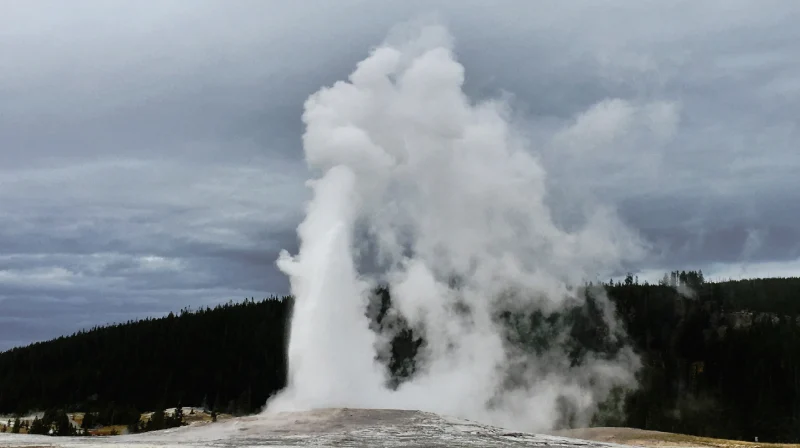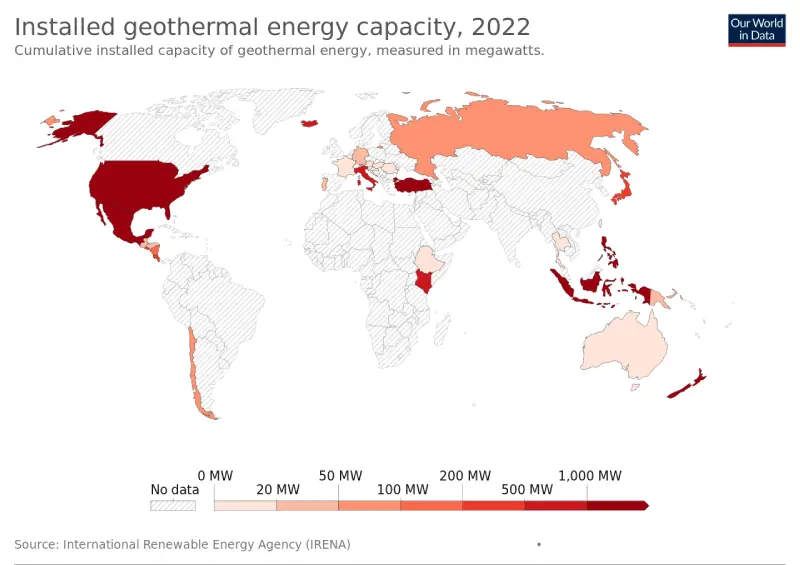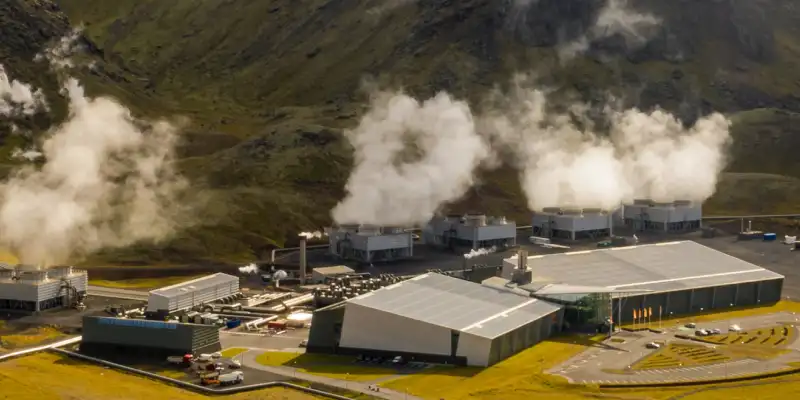What is Geothermal Energy?
Geothermal energy is synonymous with places like Iceland, where locals have harnessed the heat from its volcanoes to make this freezing land liveable. From generating electricity using hot geothermal steam to warming homes, public buildings, and even outdoor swimming pools with this freely available geothermal water.
However, geothermal energy is actually ubiquitous—even the UK has a plentiful resource!—especially when you include using shallow soils to regulate temperatures in buildings.
In this article, we cover not only the obvious aspects of geothermal energy but also delve into the lesser-known niches that will help us reach net-zero by 2050. After all, it’s almost like free energy.
Contents
- What is Geothermal Energy?
- Brief history of Geothermal energy
- How does Geothermal Power Work?
- How does Geothermal heating work?
- Is there geothermal energy in the UK?
- What’s the future of geothermal energy?
What is Geothermal Energy?

Popularly, geothermal energy refers to the generation of:
- Geothermal Power: Electricity from steam turbines driven by geothermal steam, or,
- Geothermal Heating: Hot water for heating or bathing using geothermal water.
Geothermal water is naturally occurring warm to hot water, heated by natural processes that occur at depth. For example, areas with volcanic activity or concentrated radioactive minerals are characterised by hot rocks close to the surface, which heat any groundwater that comes into contact with them.
When these hot rocks are present close to the surface, as in Iceland, Hawaii, and other volcanic areas like Yellowstone in the U.S., this water is readily available in the form of hot springs. Humans can easily use these for hot springs, saunas, natural baths, to warm buildings, or even to produce electricity via a steam turbine.
Being a natural process occurring indefinitely, geothermal energy is an inexhaustible source of renewable energy that is available 24/7 and has zero human carbon emissions.
Bonus: The Earth’s natural ability to regulate temperature is also harnessed to control the climate of buildings and public spaces by circulating water underground. When a water loop is constructed to flow underground at shallow depths (where temperatures are consistently lukewarm), the surface temperature can be regulated: it can remove excess heat from a hot building or warm up a freezing room.
Brief history of Geothermal energy
It is no exaggeration to say that geothermal energy is even considered a plausible origin of life on Earth, with deep-sea geothermal vents providing the right conditions for the first organic proteins to form.
From then on, geothermal energy has been crucial to life forms, from early micro-organisms all the way to complex animals like the American bison in Yellowstone and the Japanese snow monkeys, well-known for using geothermal springs as warm oases during harsh winters.
Then came prehistoric humans, who used geothermal hot springs for warmth, cooking, and perhaps even for ritualistic purposes. A few centuries later, the Romans, Native Americans, Chinese, Incas, Mayans, and virtually all ancient civilisations were using geothermal hot springs for bathing and heating buildings.
Fast-forward to 1904, when a significant breakthrough occurred in Larderello in Italy. It was the construction of the first geothermal power station, which utilised geothermal steam to produce electricity by driving a turbine, much like the British were doing with coal boilers.
With a capacity of 250 kW, it proved a successful proof-of-concept for future geothermal plants. Below is a short timeline of some of the major plants built around the world.
Timeline Notable Geothermal Power Stations

1904: Larderello, Italy
The world’s first geothermal power plant, with an initial capacity of approximately 250 kW. Its long-term developments have been steady, and with 34 stations, it is currently the second-largest geothermal power complex in the world, boasting a capacity of 770 MW.
The Larderello power stations are located a stone’s throw away from the famous town of Pisa and are one of Italy’s main sources of green energy. They feed directly into the Italian national grid and also provide district heating during the winter months.
1960: The Geysers, USA
Located in California, The Geysers is one of the oldest and largest geothermal power station complexes in the world. Its 22 individual stations have a whopping 1.5 GW power capacity, akin to the Didcot B Gas power station in the UK.
The electricity generated at The Geysers primarily serves the North Coast and San Francisco Bay Area regions of California. The power is fed into the local electrical grid and distributed to residential, commercial, and industrial customers through various business energy suppliers.
1973: Cerro Prieto, Mexico
Tucked in Baja, California, a few kilometres south of the U.S. border, Cerro Prieto became the largest single geothermal power station at the time of its construction, with an initial capacity of 75 MW. Its nine individual power stations are now the fifth-largest in the world by capacity, with 570 MW.
It was constructed in a bid to diversify Mexico’s energy portfolio following the 1970s oil crisis (arguably the most influential energy crisis ever), taking advantage of the geothermal expertise developed in neighbouring California, USA.
The electricity generated is fed into the national grid to produce clean baseload electricity for cities like Mexicali.
1982: Wairakei, New Zealand
New Zealand’s location in the Pacific Volcanic Arc makes it ideal for geothermal energy, and Wairakei is NZ’s main exponent. Originally built with limited capacity in 1958, it became the world’s largest geothermal power station in the 1980s with 173 MW, before further expansions at Cerro Prieto and The Geysers.
Its four power stations now have a significant capacity of 350 MW, but Wairakei is best known in geothermal circles for its environmental innovations, including the world’s largest geothermal re-injection scheme to minimise the effects of heat extraction while reducing mineral deposition in the neighbouring Waikato River.
2017: Sarulla & Gunang Salak, Indonesia
Indonesia has recently made a push for geothermal power and now has the second-largest capacity built, behind the U.S. It is likely to become the global powerhouse given its ample resources—after all, Indonesia is world-renowned for powerful volcanoes such as Krakatoa.
Both Sarulla and Gunung Salak are its main sites, with a capacity of nearly 800 MW between both complexes. Not only do these utilise the latest cutting-edge flash steam technology, but they can produce this amount of energy from solely nine power stations (compare this to 34 for a similar output in Italy).
Expect Indonesia and its other resourceful neighbour, the Philippines, to top the charts over the next couple of decades.
How does Geothermal Power Work?

One of the branches of geothermal energy is geothermal power, in which electricity is generated from hot geothermal steam. It requires sufficiently hot rocks at shallow depths to make it viable to reach the necessary temperatures for providing pressurised steam.
There are essentially three different ways to do this:
Dry Steam Geothermal (Oldest & Simplest)
This is the most traditional and simplest method, in which steam is extracted directly from underground reservoirs through pipes and directed into a turbine. It’s low-effort, highly efficient, and only possible in locations with significant volcanic or tectonic activity.
The largest geothermal plants use this technology, including The Geysers, Larderello, and Cerro Prieto.
Flash Steam Geothermal (Most common)
In Flash Steam geothermal, power plants take high-pressure hot water from the ground and decrease its pressure in a “flashing” process to produce steam, which can then be used to drive a generator’s turbine. The phase change is not a natural process, making it slightly less efficient than Dry Steam.
However, it’s more versatile as it can use any pressurised hot springs, which are virtually ubiquitous in volcanic or tectonically active areas. Most geothermal plants in Iceland and Indonesia utilise this technology.
Binary Steam Geothermal (Most Versatile)
This technology can produce electricity from lower-temperature reservoirs by using geothermal water to heat a secondary fluid with a lower boiling point, such as isobutane or isopentane, which readily boil into steam and turn a steam turbine.
The geothermal water and the secondary fluid are kept separate through a heat exchanger, ensuring that the geothermal fluid is returned to the reservoir to be reheated, forming a closed geothermal loop.
This makes this type of system extremely versatile and suitable for even the poorest of geothermal resources, such as those found in the UK!
Deep radioactive geothermal (Experimental!)
Finally, this experimental technology developed in Cornwall (UK) utilises deep geothermal resources caused by a high concentration of radioactive rocks to heat water at depth.
The process is akin to a very deep Binary Steam geothermal system in that the geothermal fluid is relatively low-temperature, and the process is kept in a closed loop, but the source of the heat is different.
This may seem inconsequential, but the presence of radioactivity at depth is also an indicator of metal concentrations. In fact, at the experimental site in Cornwall, a lithium extraction facility is being constructed to extract the high concentrations of lithium metal from the geothermal fluid!
How does Geothermal heating work?
There are essentially two ways in which geothermal energy can be used for heating applications:
Direct Geothermal Heating
Direct geothermal heating is the most efficient way of harnessing geothermal energy, as it involves using the hot water directly for human use. This may be in the form of natural hot springs and baths for health and leisure or actually using the hot geothermal fluid to replace biomass or gas boilers or other types of building heating systems, such as radiant floor heating.
This method of heating is highly efficient, sustainable, and essentially carbon-neutral, as, besides any piping, pumping, and filtering, there are no emissions from heating the water!
However, to make this economically viable, this heating method requires a hot geothermal resource close to the surface. It’s not as simple as connecting pipes to a hot spring; you also need to filter the geothermal fluid to prevent piping corrosion or mineralisation and potentially use it directly for cleaning and washing.
Therefore, these systems are mainly seen in places like Iceland, parts of the U.S., and New Zealand, which have the appropriate resources and cold climates requiring heating.
Ground Source Heat Pumps (GSHP)
This technology can be considered “fringe” geothermal in the sense that it doesn’t use hot geothermal fluids but instead utilises the Earth’s stable underground temperature for building temperature regulation.
These systems are commonly found in places prone to cold winters and without vast geothermal resources, such as Scandinavia and Canada.
Typically, these systems comprise a pipe loop installed both within a building and buried underground. A heat-transfer fluid, usually a mixture of water and antifreeze, circulates through this loop, absorbing and emitting heat from the surrounding Earth as required.
During winter, the fluid absorbs heat from the ground and transfers it to the building through a heat exchanger connected to the building’s heating system.
During summer, the fluid absorbs heat from the building and releases it into the cooler ground in contact with the underground pipes, passively maintaining the temperature without needing energy-intensive air heat pumps or air conditioning units.
Bonus: GSHP is a variant of ancient heating techniques used by civilisations like the Incas and Persians. The Incas passed irrigation canals within the floors of their stone buildings, passively maintaining stable temperatures throughout the year, while the Persians did the same within their desert palaces.
Is there geothermal energy in the UK?
Despite not having the same quality of geothermal resources as Iceland or Italy, the UK has historically exploited its limited resources. Here are a few examples:
- Hot Springs (South West England): The Bath hot springs are believed to have been discovered by the ancient Celts and were extensively developed by the Romans in the first century AD for their spa town named Aquae Sulis, now part of Bath. Bath is now an exclusive spa destination and a popular tourist attraction.
- Deep Radioactive Geothermal (Cornwall): The United Downs project, under development in Cornwall, is a cutting-edge geothermal initiative that will be used to generate electricity, provide local district heating, and even extract precious lithium.
- GSHP (Everywhere): This technology has been used in various buildings across the UK since its inception and is more prevalent in rural areas where building methods have been less standardised than in cities. Recently, GSHP systems have been installed in new developments aiming to be more sustainable and low-carbon.
What’s the future of geothermal energy?
We don’t have a crystal ball, but geothermal energy remains one of the most promising renewable energy sources despite being less popular than the burgeoning intermittent solar and wind power or the institutionalised hydro and run-of-the-river hydropower. Let’s briefly examine the advantages and disadvantages to understand its promising yet limited future:
Advantages of Geothermal Energy
✅ Can produce baseload, 24/7 renewable, low-carbon electricity and heating (unlike wind and solar power, which depend on weather conditions).
✅ Geothermal power is cost-effective in areas with ample resources. For example, Iceland has some of the cheapest electricity in the world, and 30% of it comes from geothermal sources.
✅ All types of geothermal energy have virtually zero operational carbon emissions and are extremely robust, as underground geothermal resources change at geological timescales (millions of years!).
✅ Geothermal systems can often generate electricity and heat simultaneously without additional infrastructure.
✅ Geothermal power outputs are limited compared to other renewable technologies. The largest Geysers is only capable of 1.5 GW, which pales in comparison to the Gansu Wind Farm (~20 GW) or Three Gorges Dam (~22.5 GW)
Disadvantages of geothermal energy
❌ Geothermal power is often only viable in areas with excellent geothermal resources, with solar and wind often being cheaper alternatives.
❌ Binary and deep geothermal installations may be risky for investors as they take many years to develop and may trigger earthquakes, similar to fracking. This is because injection and production wells require drilling, which is also expensive.
❌ GSHP is often only a partial heating solution that is not as easily adjustable as gas boilers or heat pumps. They can only cool or warm a building to a certain extent and are challenging to install in existing buildings. Despite being simple systems, there is little expertise in places like the UK, requiring a relatively large initial investment.
❌ Geothermal energy cannot be used for energy storage.
Conclusion
These pros and cons paint a clear picture. While geothermal energy is likely the most robust, sustainable, and low-carbon type of renewable energy, its scalability is limited due to costs, expertise, and specific geological conditions required for construction.
However, rapid technological innovation may change this over the next decade, such as the advent of super-cheap drilling, incredibly high-resolution geophysical imaging, or extremely efficient heat exchangers.
FAQs
In this FAQ section, we address the questions that commonly follow “What is geothermal energy?”.
Is Geothermal energy renewable?
Yes, geothermal power is considered renewable as it is essentially a non-exhaustive source of energy that is driven by geological processes within the Earth. It also involves no direct emission of greenhouse gases during the generation process.
In contrast, traditional power plants rely on fossil fuels like coal or natural gas to generate electricity, but these fuels have a limited supply and will exhaust. They also directly release carbon dioxide into the atmosphere.
Geothermal power stations operate in over 70 countries and contribute to more than 1% of global power demand.
Where does Geothermal energy come from?
Geothermal Energy is a broad term for energy in the form of heat stored beneath the Earth’s surface. Below the Earth’s crust, temperatures can exceed 4,000 degrees Celsius. The source of this heat is believed to originate from two processes:
- The decay of radioactive materials within the Earth.
- Gravitational potential energy is released during the planet’s early formation.
Where can I find an energy tariff that uses geothermal power?
Geothermal power is not yet available for purchase in the UK, but this may change in the coming decade. Once it becomes available, you can use our business energy comparison service to switch to a green energy tariff that also includes energy from a variety of other low-carbon sources such as nuclear, hydro, wind, and solar.
And if you just want to compare individual utility suppliers, make sure to compare gas, electricity and water separately:
Bonus guides:

